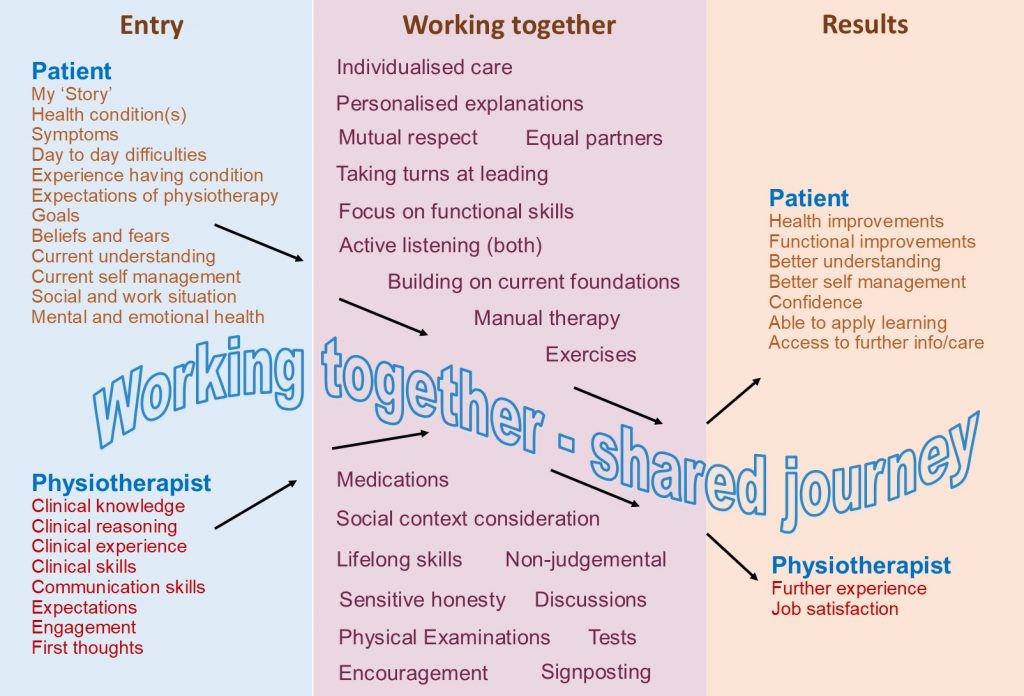I have written this blog primarily, but not exclusively, to support other people living with persistent pain, and who are either about to attend, or currently attending, physiotherapy.
Physiotherapy has been life-changing for me, but it took a few years for me to find the physiotherapist that was best matched to my condition, and a few years for me to learn how to make the most of my physiotherapy care.
In the first half of the blog I look at my own physiotherapy journey, and use this to explain my thoughts about how to get the most out of physiotherapy.
In the second half of the blog I explain what I do as a patient now in order to make the most of my physiotherapy. They are things that I wished I had done from the beginning of my physiotherapy care. They are only my thoughts, nothing more. Hopefully you may find something in there that helps you with your physiotherapy care.
You may well have other ideas about how to get the best out of physiotherapy and I’d love to hear them. Please use the contact form on my website, or leave a comment at the end of the blog.
My personal physiotherapy experience is related to musculoskeletal conditions (shoulder, back and sciatic nerve), but I think the fundamentals relate to all physiotherapy care, and indeed other health care.
My physiotherapy journey

Like many others I was brought up to do whatever a doctor or other healthcare professional asked of me, without question. I was fundamentally a passive patient.
There was nothing in my upbringing, or in my experience of society’s approach to the medical world, to suggest I had shared responsibility for making decisions about my health care.
I’m sure my passivity meant my health care was less effective than it could have been.
Following a manual handling accident in 2008 I sustained a prolapsed lumbar disc that unfortunately, and I think unusually, resulted in permanent sciatic nerve damage and on-going back pain.
I have received a number of episodes of physiotherapy care, some of which were more successful than others. Throughout this blog there is no criticism intended about any of my health care.
I have been on a journey, both with my persistent pain condition and with my understanding of how to be an effective partner in my care. I have gradually learnt to be a more active patient, and to take shared responsibility for my health care. I am now able to get much more out of my care, and I hope my physiotherapists are able to get much more out of treating me. It has been a long, but worthwhile journey.
A passive patient

I entered my first episode of physiotherapy care shortly after being in hospital for 5 days. I was barely able to walk and had great difficulty either sitting down or standing. I was in excruciating pain and on a great deal of pain medication.
I entered the physiotherapy consulting room as a passive patient with a subconscious expectation that I would be told by the physiotherapist what to do. I had no real idea what a physiotherapist did and how they could help me. I had no idea about the different methods physiotherapists use, and I had no idea what I needed to do to get the best out of my care.
I was conscientious and undertook the minimal exercises I was asked to do. Reflecting back on those sessions I suspect those minimal exercises weren’t ever going to be effective enough to make the large physical improvements I needed to make, but I didn’t realise that at the time.
Outside of physiotherapy I was determined to improve my situation and did what I could to help myself get back to being able to walk and manage independently. I received no professional help or guidance with this.
It’s obvious to me now that I could have asked my physiotherapist to focus their support on improving my ability to walk again. I could have asked for consideration of walking aids to use short term to help. I could have asked for help to increase my independence overall. I didn’t need to try to do all these things on my own.
I was fully blinkered in terms of doing what was suggested to me, and not asking for, or expecting, anything further. I was an unequal partner in my care. I expected my physiotherapist to take the lead, and for me to blindly follow.
Becoming an active patient

Over the next few years I gradually became less passive in my physiotherapy care, and more active. I gradually became a more equal partner.
Four years into my persistent pain journey I experienced an episode of care with a physiotherapist called Matt. Matt is a spinal specialist and has an interest in persistent pain. Matt subtly and sensitively taught me how to become a more active and more equal partner in my care.
We worked in partnership together with the aim of improving my pain and situation. I brought to the partnership my unique experience of my condition and the difficulties it was causing me, and Matt brought his clinical knowledge, clinical reasoning and extensive experience.
Through discussion and sharing of our individual perspectives, experiences and expertise we were jointly able to improve my pain and my situation. I learnt to understand and manage my pain better, and our combined efforts improved my functional skills.
Sharing responsibility for my physiotherapy care

I firmly believe that the best physiotherapy care happens when the patient and the physiotherapist work in equal partnership. Each have a different set of skills and experience they bring into the partnership. Through discussion, and working together, these different perspectives, skills and experience can be effectively combined to provide the patient with the best possible care.
The diagram below gives an indication of how this partnership worked for me with Matt. You can see the skills and experience that we both brought into the partnership, the journey we took together, and the results.

I think the diagram illustrates well that if the ‘partnership’ is predominantly one sided (either side) then the results cannot possibly be as good. I believe this was the situation when I was being a ‘passive’ patient. My physiotherapists at that time were only aware of a fraction of my story. They were making decisions that affected me, but didn’t fully involve me, and I was blindly following.
Although Matt and I worked in partnership, and shared responsibility for decision making, there were times when I took an active lead, and times when Matt did. Sometimes, particularly when I felt overwhelmed by my situation, I took a more passive role, and sometimes I took the lead. The lead changed imperceptibly between us.
If I had my time again, I would have taken a more active role in my care right from the start. I would have entered all my episodes of care as an equal partner, taking shared responsibility. Unfortunately at that time I didn’t know how to do this.
Making the most of physiotherapy
I hope in the rest of this blog to outline how I would approach my physiotherapy care from the start if I could have my time again. I hope you find there is something here that can help you become a more empowered and active patient, and better able to share responsibility for your care with your physiotherapist.
Understanding more about physiotherapy

I’m pretty sure I didn’t have much idea about what physiotherapists do before starting my physiotherapy care. I had little clue what to expect when I first entered the clinic door. I’m convinced I could have been a more active and effective partner if I had.
I didn’t know there was a range of different physiotherapy treatment options available to me. I didn’t know that different physiotherapists specialise in different sections of the body. I didn’t know that a physiotherapist could help me learn to live with my persistent pain condition better, through helping me to understand my persistent pain and through learning how to manage it.
With more knowledge I could have recognised that my physiotherapy care wasn’t always well matched to me, and I could have asked for something different.
Once you know you are being referred to physiotherapy I recommend you start to look in more detail at what physiotherapy is, and what it can offer you.
I have found it difficult to find good information on the Internet about what a physiotherapist does, but the webpage you can access by clicking HERE seems quite helpful. This information is from the Chartered Society of Physiotherapists (CSP). It hasn’t been written for patients specifically, but is quite helpful.
Another quite interesting article, again not written for patients directly, can be accessed HERE. This is an article also written by/for the CSP.
The NHS webpage that explains physiotherapy can be accessed by clicking HERE.
There are various YouTube videos that explain what a physiotherapist does, but I haven’t found any yet that I personally particularly like, and so I haven’t referenced any here.
Most physiotherapists specialise in one sub-section of physiotherapy, for example hand rehabilitation, paediatrics, musculoskeletal, respiratory, women’s health or neurology. I’m guessing there are 20 or more physiotherapy sub-sections. It’s therefore important that you not only find out about what physiotherapists do in general, but also how they they might work with your particular condition.
If I had understood more about physiotherapy, and more about the different types of physiotherapy care available to me, then I might have been better empowered to ask for a better matched physiotherapist much sooner.
Finding the right physiotherapist

My progress improved when I started working with a physiotherapist that was well matched to both me as a person and to my condition.
It isn’t always possible, particularly if you are receiving care within the NHS, to choose your physiotherapist, but if you are able to then it is well worth doing some research in order to try to find the best possible match for you.
If you are a private patient then you can do some basic Internet research to find out about the physiotherapy clinics in your area. Most private physiotherapy clinics have a website, as do an increasing number of NHS clinics.
Try to find a clinic / physiotherapist that specialises in your condition. Some are specialist in back conditions, some in shoulders, some in sports rehabilitation etc. If you live in persistent pain, then try to find a physiotherapist who frequently supports patients with persistent pain.
The Chartered Society of Physiotherapy (CSP) have a website which includes a section to help you find a physiotherapist. You can access this by clicking HERE.
Once you have the name of a physiotherapist that you are considering then it is worth typing their name into Google or another Internet search engine to see if you can find any further information about them.
Personal recommendation is a good way to find a physiotherapist, but make sure that the physiotherapist is a good match for your health condition, which may be different to the person recommending them!
If your physiotherapy care is via the NHS then you may be more limited in being able to influence the match of your physiotherapist to your health condition, and to you as a person. However, if you want a particular NHS physiotherapist then it is worth asking your doctor or consultant to request that physiotherapist when they write their letter of referral. This can work!
Before the first appointment

I attended my first physiotherapy appointment without undertaking any preparation. I have since learnt that putting some time and thought into that first appointment can make it easier for you and your physiotherapist to get started on an episode of care that will give you the best possible outcomes.
In advance of your first appointment, your physiotherapist will have been given only basic details about your physical condition. They are unlikely to have much information about how your condition is affecting you, both physically and emotionally. It’s unlikely they will have much, if any, information about what you personally hope to get out of your physiotherapy care. You will need to fill in these gaps.
The best possible care will be achieved if you can share with your physiotherapist how your condition affects you both physically and emotionally. It will also help if you share what it is in your everyday life that you are practically finding difficult to do and what you would like support in being able to achieve again.
I now write down my thoughts which helps me to clarify them in my own mind and also provides a quick way of filling in the gaps for my physiotherapist.
I write my thoughts down on one side of A4. I never go over this as it would be too much for my physiotherapist to read in one go. I use bullet points for ease of reading. I don’t write an essay! An example of my writing for a first appointment can be found HERE.
You can then take your writing to your first physiotherapy appointment and give it to your physiotherapist. This not only helps to give them some insight into your thoughts, which they can then build on, but it also helps set the therapeutic relationship as a true partnership from the very beginning.
During appointments

During the start of any appointment I give my physiotherapist any writing I have done for them. My physiotherapist is skilled at picking out ‘themes’ from my writing, and then working with me to tailor both the session and my overall care accordingly.
Don’t forget that the physiotherapist is there to work in partnership with you to improve your condition and situation. They aren’t there to just tell you what to do as I once thought! You need their clinical experience and clinical expertise, but equally they need your insight into how your condition affects you. You need to work throughout your episode of care together.
It’s important you take an active part in discussions. Don’t worry if you find it difficult to explain where, for example, any pain comes from, what makes it worse or what makes it better, just try your best to explain. Ask if you can draw pictures to explain if that helps. Use whatever methods you need to in order to communicate your thoughts the best you can.
Equally if you don’t understand something your physiotherapist is telling you, then make sure you ask them to explain again, and maybe in a different way. I’m sure they will be very happy to do so.
Ask your physiotherapist about different treatment options. There is often more than one way to approach a health difficulty, and the best way for you is likely to be the one that you ‘buy into’. Share any decision making.
It is likely that your physiotherapist will suggest some exercises to improve your situation. Make sure you understand what their purpose is, and exactly what you need to do. I find simple diagrams drawn by the physiotherapist help me to remember what to do. Ask how much pain or discomfort is ‘ok’ when you do the exercises.
Remember one of the main aims of physiotherapy is to improve your ability to be independent. In order to achieve this you will need to make sure your physiotherapist is aware of any difficulties you are having, and discuss them. Hopefully together you will work out ways to overcome these difficulties. Sometimes your physiotherapist may ask another healthcare professional to assist, for example an occupational therapist.
Work with your physiotherapist to understand how better to manage your condition, and any pain. Discuss how to avoid flare ups, but also discuss what to do when they do happen, as they inevitably sometimes will. Discuss the factors that make your pain or condition worse, and those that make it better.
One of the most important things my physiotherapist helped me understand is that there are a wide range of factors impacting on my pain condition, sometimes negatively, and sometimes positively. For example negative stress often makes my pain worse, having good friendships and relaxing makes it better. Cold weather and poor sleep increases my pain, as does sitting on trains for a long time!
Be prepared for discussions with your physiotherapist to be wide-ranging and not just focussed on the affected body part. Your physiotherapist can work with you to help you understand what might be impacting on your condition. Once you have a better understanding of this then you can work on ways to improve your situation.
Learning to understand the range of factors that impact on my persistent pain condition, and then working out mainly for myself what I could do to improve them, was hugely important for me.
Finally, don’t forget at the end of your appointment to check your understanding of what you need to do before your next appointment. Don’t be afraid to ask your physiotherapist to write things down for you.
In-between appointments

Chances are you will have been given some exercises to do, or some other things to do or try before the next appointment. Try to work out a schedule to fit them in. If you want to get the most out of your care then it’s worth making sure you conscientiously do them!
Don’t only do what you have agreed with your physiotherapist. Be pro-active, take the opportunity to continue learning about your condition, and try different things for yourself. If you are having difficulties with independent daily living, for example having a shower because you find it difficult to stand for a long time, then do some research on the Internet for aids and adaptations that may help, for example a shower seat. If you need some advice from your physiotherapist, then write a note to remind yourself to ask at the next appointment.
Think about what you and your physiotherapist discussed in terms of your understanding of your condition. Did you understand what you were told? Would it help to research a bit on the Internet (remember though that everything you read on the Internet may not be right!). Maybe write down which bits you are having trouble understanding so that you can ask your physiotherapist next time.
Continue to think about what difficulties your condition is causing you so that you can discuss these with your physiotherapist. These are your physiotherapy sessions and you need to make sure you get out of them what will be most helpful to you. Remember your physiotherapist isn’t a mind reader so you will need to tell them about any difficulties you are having, otherwise they just won’t know.
Before the next appointment

Just before your next physiotherapy appointment, reflect on your progress since the last one. Be honest with yourself. How did you get on with the exercises or other work you had agreed with your physiotherapist to do? Have you done any other learning of your own? Have you made any changes to enable your independence and manage your pain or condition better?
Perhaps write down your thoughts so that you can give them to your physiotherapist at the beginning of your next session.
Try to keep your writing to one side of A4 paper so that you don’t overwhelm your physiotherapist, and try to use bullet points and simplified language. You can read an example of my writing by clicking HERE.
Reflect on practical things you have found difficult since your last appointment and write these down. Don’t worry if you think your physiotherapist might not be able to help with them, if they are important to you then they are worth sharing.
Reflect on whether you think the physiotherapy sessions are working for you or not. If not, then try to think about why. Write these thoughts down so you can discuss them with your physiotherapist next session. If you feel uncomfortable about discussing them with your physiotherapist then ask the clinic receptionist if there is someone else you could discuss them with.
Think through if there is anything from the last session, or your learning in between sessions, that you don’t understand and write this down. I’m sure your physiotherapist will be happy to explain next time.
The last appointment

Try to get your physiotherapist to warn you in advance when your last appointment is going to be, so you can prepare for it. My experience is that physiotherapists don’t always forewarn you, which can mean you leave your last appointment wishing you had asked some important questions. If you think they are not going to warn you in advance, then prepare your ‘last appointment’ questions for every appointment, just in case!
During your last appointment, or before, make sure you have talked to your physiotherapist about what to do in the future if things don’t improve or if they get much worse.
If you are a private patient then discuss whether ‘occasional’ appointments, or a ‘review’ appointment would be helpful. Unfortunately if you are an NHS patient it is unlikely you will be offered this. Some private physiotherapy clinics offer telephone or Skype type appointments, which may be useful for keeping in touch with your physiotherapist over time.
Make sure you have discussed any other services that might be able to help you further, for example occupational therapy. Ask how to access them.
Ask if there are any support groups in the locality that might be worth looking into, or any websites or blogs that might be worth following.
Finally, don’t forget to reflect on your progress with your physiotherapist. It’s important for both of you to jointly consider how effective your treatment has been.
After your episode of care

It’s important you don’t stop working on improving your health condition and situation once your episode of physiotherapy care finishes.
Hopefully you will have learnt some techniques which you can use to manage your situation going forward. You will need to think about how you can use these techniques in your everyday life.
Do continue learning about your condition, and do continue striving for as much independence as possible. Your condition and situation shouldn’t just improve whilst working with a physiotherapist, you should be able to use what you have learnt to make further improvements yourself. You need to believe you can self-manage and improve your condition, because you can, and you need to put time aside to think through how!
Final thoughts

Although it was a long journey for me personally to transition from being a passive patient to one that was much more active, and better able to share responsibility for my health care, it has been a hugely important one.
Through my shared partnership with my physiotherapist, Matt, I have learnt how to manage my persistent pain condition much better and I have became more functionally independent.
I hope this blog will help you become a more empowered and active patient and I hope it will help you make the most of your physiotherapy care.











I like that you mention how having a patient work in a partnership with their physiotherapists can provide the best care. If you’re looking for one, it would probably be a good idea to research and meet with potential physiotherapists. This could give you the chance to find one that you’re comfortable with and can work with in order to get the best care for your situation.
Thank you, and yes I agree that researching and meeting potential physiotherapists first is a really good idea. Working in partnership with your physiotherapist is so important, and you can do that more effectively with one that you are comfortable with.
Tina
My daughter hurt her back cliff diving recently and can’t seem to get over the pain that comes up multiple times a day. I’ll let her know that a physiotherapist will be able to help her with the extended pain that she has been having. Your article does a great job of sharing your story and the details that helped you get better.
Thank you🙏🙏🙏
Sounds like a nasty accident. Hope your daughter is feeling a bit better 🤞🤞🤞.
Thanks for the information you shared. I love how you relate your experience with physiotherapy journey. I’ve been a patient of chronic pain, and thanks to you I’ve been motivated to become an active patient. I will participate actively from now on.
Wow – your comment makes all the time I’ve put into writing some of these blog posts worthwhile! Thank you 🙏🙏🙏
I’m trying to get rid of the pain in my body, but I’m not sure how to go about it. It makes sense that physiotherapy might be able to help me out with this. I’ll be sure to find someone who can help me throughout this journey.
Hope things work out well for you 😊😊😊
I like the example you gave of seeing a physiotherapist who specializes in persistent body pains if you are having persistent body pains. People should look for the physiotherapist that best matches their needs, not all of them are the same just like every pain is not the same. Thank you for this advice, it will help tons of people find the right physiotherapist.
Thank you David. Yes, I agree, really important to find the right physiotherapist both for your condition, and for you personally. Well worth it. 😊
Great Post!Thank you so much for sharing this kind of wonderful things.
Wow… thank you 🙏🙏🙏
Hello, thanks for an in-depth guide for patients to learn about physiotherapy. It’s really neccessary for such articles to be published to raise awareness and improve the outcomes. Thank you!
Thank you Lucus 🙏🙏🙏
I appreciate your advice about finding a physiotherapist and preparing for the appointment. My leg hasn’t been well since I got in an accident recently, so I’m thinking of getting someone to help out. The information here will help me make the most of my time to get better quickly.
Thanks Oscar, although sorry to hear about your accident.
Let me know if you find the leaflet useful in practice or not…
Tina
I’ve been having a lot of issues with chronic pain, and I’m not sure what I can do about it. It’s interesting that a physiotherapist can help with this kind of thing. Maybe it would be a good idea for me to talk to one to see what they can do.
Hi Braden
I would definitely recommend talking to a physiotherapist! Maybe try and find one that has specific expertise in your condition if possible?
Tina